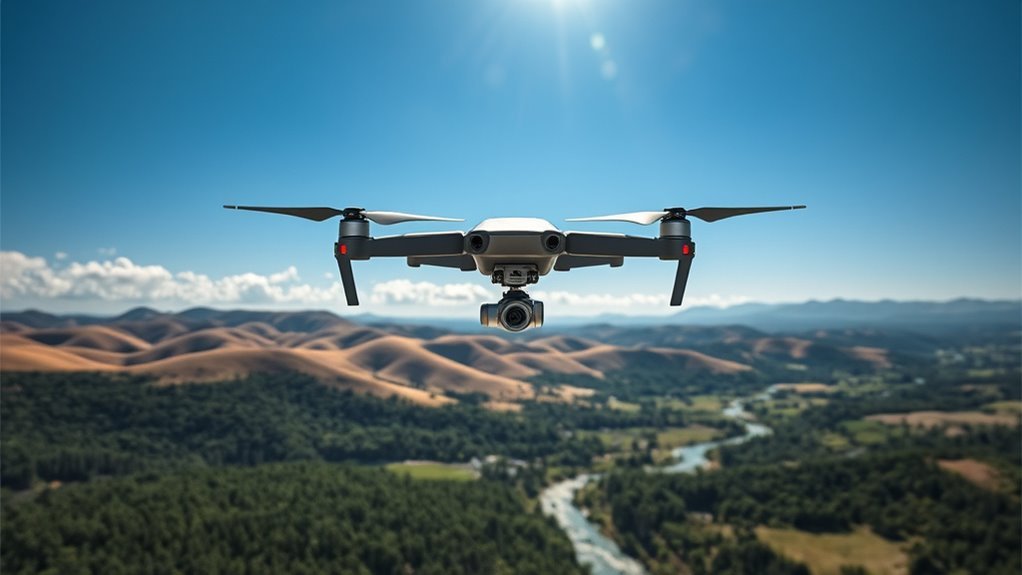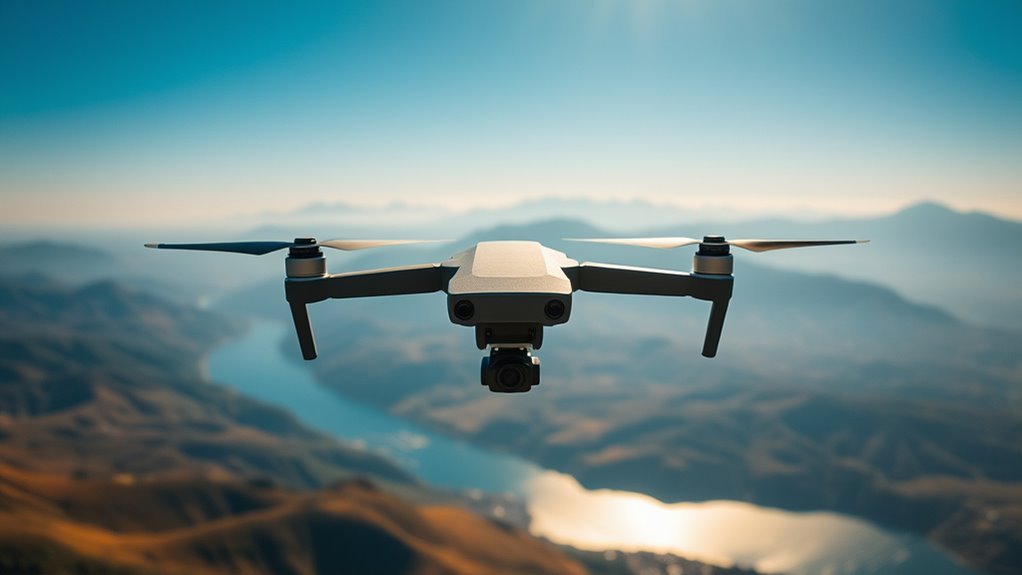Several factors affect your drone’s range, including battery life and capacity, which determine flight duration. Weight and payload influence lift capability; excess weight can lead to increased power consumption. Weather conditions like wind and temperature can impact performance, while transmission technology plays a role in signal strength and operational distance. Additionally, flight modes and cruising speeds should be optimized for efficiency. Understanding these elements can considerably enhance your drone’s operational potential. More insights await you ahead.
Battery Life and Capacity

Battery life and capacity greatly influence a drone’s operational range, as they determine how long the aircraft can stay airborne before needing a recharge. Understanding battery chemistry is essential; lithium-polymer (LiPo) batteries, for instance, provide high energy density but may compromise energy efficiency at lower temperatures. You’ll want to evaluate how the drone’s design and usage affect power consumption. Factors like flight speed, altitude, and payload can considerably impact battery performance. Additionally, the XG Neith Drone features high-capacity lithium-polymer batteries that enhance stability and longevity, further extending your drone’s range. By optimizing these variables, you can extend your drone’s range. Additionally, advancements in battery technology aim to enhance energy efficiency, allowing for longer flights without compromising performance. Ultimately, striking the right balance between battery capacity and energy demands is key to maximizing your drone’s operational potential. Battery types significantly influence flight duration, as different chemistries offer varying levels of energy efficiency.
Weight and Payload

While you may focus on battery life when considering a drone’s range, the weight and payload also play critical roles in determining how far a drone can travel. The total weight impacts the drone’s lift capability, with excess weight leading to increased power consumption. Ideal payload distribution is essential; if the load is uneven, it can adversely affect stability and efficiency, further reducing range. In drone design, engineers must carefully balance payload capacities with structural integrity to maximize performance. Understanding these factors allows you to make informed decisions about your drone’s usage and capabilities. Ultimately, managing weight and payload effectively gives you the freedom to explore and expand your drone’s operational potential. Additionally, battery capacity is crucial as it limits the operational freedom of the drone, potentially influencing the overall flight distance.
Weather Conditions

The performance of drones is not solely dependent on weight and payload; weather conditions significantly influence their operational range as well. Wind speed can greatly impact a drone’s ability to maintain stability and navigate efficiently. High wind speeds may force you to reduce operational distances, as drones struggle against strong gusts, leading to increased energy consumption and potential loss of control. Additionally, temperature effects play an essential role; extreme heat can diminish battery efficiency, while cold temperatures may reduce propulsion power. Efficient power management is crucial for optimizing energy use, which is particularly important when facing adverse weather conditions. These factors intertwine, affecting your drone’s flight time and overall range. To maximize your drone’s performance, always check the weather conditions before heading out, ensuring you’re prepared for the challenges posed by wind and temperature. Understanding battery efficiency is crucial to managing the impact of these environmental variables.
Transmission Technology
As you explore the capabilities of drones, understanding transmission technology becomes essential for optimizing their range. The effectiveness of communication relies heavily on signal strength and the protocols used for data transmission. High-quality transmission systems can enhance the drone’s ability to maintain a stable connection, even at extended distances. Various communication protocols, such as Wi-Fi, LTE, and specialized RF technologies, each have unique benefits and limitations regarding range and interference. For instance, LTE can offer greater distance but might require more power compared to short-range Wi-Fi. By selecting the right combination of signal strength and communication protocols, you can markedly improve your drone’s operational range, ensuring greater freedom in its applications and missions. Additionally, understanding frequency bands used in drone communication can further optimize performance and minimize interference. Yuneec’s software employs advanced algorithms to maintain reliable links that can significantly enhance communication stability across varying distances.
Flight Mode and Speed
Effective transmission technology sets the stage for how flight mode and speed impact a drone’s range. Your drone’s flight efficiency is greatly influenced by its aerodynamic design and chosen flight mode. For example, cruising at ideal speeds and using efficient flight modes can maximize range. Additionally, aerodynamic design plays a crucial role in reducing drag and conserving energy, further enhancing the overall flight distance. Furthermore, understanding power management is essential for optimizing performance in different flight modes.
| Flight Mode | Speed (mph) | Range Impact |
|---|---|---|
| Hovering | 0 | Low |
| Cruising | 15 | High |
| Sport Mode | 30 | Moderate |
| Eco Mode | 10 | Very High |
Frequently Asked Questions
How Does Drone Design Influence Its Overall Range?
When you design a drone, think of it as a bird; aerodynamic efficiency and weight distribution shape its flight. A well-balanced design extends its range, allowing you to explore uncharted skies with ease and freedom.
Can Terrain Affect a Drone’s Operational Range?
Yes, terrain types and elevation changes greatly impact a drone’s operational range. Uneven landscapes can cause increased energy consumption, reducing flight efficiency. You’ll need to plan routes carefully to maximize your drone’s performance in varying environments.
What Role Does Drone Maintenance Play in Range Efficiency?
While neglecting maintenance schedules can lead to component wear and reduced performance, regular upkeep guarantees your drone operates efficiently. Balancing proactive care with necessary repairs maximizes its range and enhances your operational freedom.
Are There Regulations That Limit Drone Range?
Yes, drone legislation often imposes flight restrictions that can limit your drone’s range. Understanding these regulations is essential for maximizing your operational freedom while ensuring compliance with safety standards and airspace management requirements.
How Do Battery Temperatures Impact Drone Range?
Imagine a drone soaring through a thermal landscape. Battery efficiency suffers in temperature extremes; both cold and heat can diminish performance, limiting your flight range. So, monitor those conditions to maintain ideal drone functionality and freedom.

